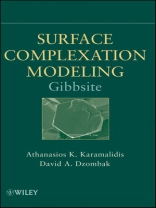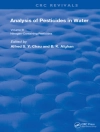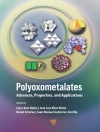This book provides a description of the generalized two layer surface complexation model, data treatment procedures, and thermodynamic constants for sorption of metal cations and anions on gibbsite, the most common form of aluminum oxide found in nature and one of the most abundant minerals in soils, sediments, and natural waters. The book provides a synopsis of aluminum oxide forms and a clearly defined nomenclature. Compilations of available data for sorption of metal cations and anions on gibbsite are presented, and the results of surface complexation model fitting of these data are given. The consistency of the thermodynamic surface complexation constants extracted from the data is examined through development of linear free energy relationships which are also used to predict thermodynamic constants for ions for which insufficient data are available to extract constants. The book concludes with a comparison of constants extracted from data for sorption on gibbsite with those determined previously for hydrous ferric oxide (HFO), hydrous manganese oxide (HMO), and goethite.
The overall objective of this book is the development and presentation of an internally consistent thermodynamic database for sorption of inorganic cations and anions on gibbsite, an abundant and reactive mineral in soils, sediments, and aquatic systems. Its surface has a high affinity for sorption of metal cations and anions, including radionuclides. The gibbsite database will enable simulation and prediction of the influence of sorption on the fate of these chemical species in natural systems and treatment processes in which aluminum oxides are abundant. It thus will help to advance the practical application of surface complexation modeling.
Inhaltsverzeichnis
Foreword xi
Preface xiii
1 Aluminum Oxides and Hydroxides under Environmental Conditions 1
1.1 Introduction 1
1.2 Occurrence of Aluminum Oxides and Hydroxides in the Subsurface 2
1.3 Occurrence of Aluminum Oxides and Hydroxides in Surface Water 4
1.4 Use of Aluminum Hydroxide in Water Treatment 6
1.5 Summary 7
2 Formation and Properties of Gibbsite and Closely Related Minerals 9
2.1 Al Polymerization Models 9
2.1.1 The “Core-Links” Model 10
2.1.2 The “Cage-Like” (Keggin-Al 13 Structure) Model 10
2.1.3 The “Continuous” Model 11
2.2 Formation of Gibbsite and Other Al Hydroxides and Oxyhydroxides 12
2.3 Aluminum Hydroxide Polymorphs: Structure and Nomenclature 15
2.4 Gibbsite 19
2.4.1 Kinetics of Precipitation and Crystal Growth 19
2.4.2 Structure 21
2.4.3 Common Techniques of Synthesis 21
2.4.4 Synthesized Gibbsite and Differences from Natural Gibbsite 24
2.5 Bayerite 25
2.5.1 Kinetics of Precipitation and Crystal Growth 25
2.5.2 Structure 26
2.5.3 Differences from Gibbsite 26
2.5.4 Synthesized Bayerite and Transformation to Gibbsite 27
2.6 Nordstrandite 27
2.7 Doyleite 28
2.8 Other Forms of Aluminum Oxides and Oxyhydroxides 28
2.8.1 Corundum (a-Al 2 O 3) 28
2.8.2 Boehmite (g-Al OOH) 29
2.8.3 Diaspore (a-Al OOH) 29
2.9 Other Forms Manufactured under High Temperature and Pressure 30
3 Types of Available Data 33
3.1 Gibbsite Structure Verification 33
3.2 Physical–Chemical Properties 34
3.2.1 Specific Surface Area 34
3.2.2 Surface Site Characterization 35
3.2.2.1 Hydroxyl Surface Sites 35
3.2.2.2 Surface Site Density 36
3.3 Acid–Base Titration Data 37
3.4 Cation and Anion-Sorption Data 40
3.5 Spectroscopic Data for Sorption on Gibbsite 41
3.6 Proton Release Uptake Data 43
3.7 Electrokinetic Data 43
3.8 Summary 44
4 Data Compilation and Treatment Methods 45
4.1 Collection of Data 45
4.2 Assessment of Data Quality 46
4.2.1 Solid Preparation Method 46
4.2.2 Type of Reaction Vessel 47
4.2.3 Nature of Background Electrolyte 47
4.2.4 Sorption Kinetics 48
4.2.4.1 Proton Sorption Kinetics 48
4.2.4.2 Cation and Anion Sorption Kinetics 49
4.2.5 Method of Solid–Liquid Separation 49
4.2.6 CO 2 Exclusion 50
4.2.7 Experimental Temperature 51
4.3 Compilation of Surface Properties 51
4.4 Extraction of Equilibrium Sorption Constants 51
4.4.1 Solution Activity Coefficients 52
4.4.2 Fiteql 52
4.4.3 Data Grouping 54
4.4.4 Selection of Surface Species 54
4.4.5 Selection of Best Estimates 55
4.5 Optimal-Fit Simulations 56
4.6 Presentation of Results 56
5 Surface Properties of Gibbsite 59
5.1 Surface Area 59
5.2 Site Density 62
5.3 Point of Zero Charge 64
5.4 Surface Acid–Base Chemistry 65
5.5 Effects of Dissolution on Gibbsite Surface Acid–Base Chemistry 76
5.6 Summary 80
6 Cation Sorption on Gibbsite 81
6.1 Modeling Methodology and Reactions 81
6.2 Available Spectroscopic Data and Use in Modeling 86
6.2.1 Copper 86
6.2.2 Lead 87
6.2.3 Cobalt 88
6.2.4 Cadmium 88
6.2.5 Manganese 88
6.2.6 Iron(II) 88
6.2.7 Calcium 88
6.2.8 Zinc 89
6.2.9 Mercury 89
6.2.10 Uranium 90
6.2.11 Thorium 91
6.3 Copper 92
6.4 Lead 99
6.5 Cobalt 107
6.6 Cadmium 117
6.7 Manganese 126
6.8 Iron (II) 127
6.9 Calcium 128
6.10 Zinc 130
6.11 Mercury 132
6.12 Uranium 142
6.13 Thorium 145
7 Anion Sorption on Gibbsite 149
7.1 Modeling Methodology and Reactions 149
7.2 Available Spectroscopic Data and Use in Modeling 153
7.2.1 Phosphate 153
7.2.2 Arsenate 154
7.2.3 Arsenite 154
7.2.4 Molybdate 155
7.2.5 Selenate 155
7.2.6 Chromate 155
7.2.7 Borate 155
7.2.8 Sulfate 156
7.2.9 Fluoride 156
7.2.10 Silicate 156
7.3 Phosphate 157
7.4 Arsenate 164
7.5 Arsenite 176
7.6 Molybdate 182
7.7 Selenate 185
7.8 Chromate 187
7.9 Borate 188
7.10 Sulfate 192
7.11 Fluoride 195
7.12 Silicate 197
8 Coherence and Extrapolation of the Results 199
8.1 Cation Sorption on Gibbsite 199
8.2 Anion Sorption on Gibbsite 204
8.3 Comparison of Gibbsite Surface-Complexation Constants with Those of Goethite, Hydrous Ferric Oxide, and Hydrous Manganese Oxide 208
8.4 Summary 213
References 219
Appendix A: Summary of Experimental Details 241
Author Index 283
Subject Index 289
Über den Autor
ATHANASIOS K. KARAMALIDIS is a Research Assistant Professor in the Department of Civil and Environmental Engineering at Carnegie Mellon University. He has conducted research on the dissolution and surface reactions of complex mineral assemblages in aqueous systems. He has published his work in peer-reviewed international journals in environmental engineering and science, and in the proceedings of international conferences.
DAVID A. DZOMBAK is the Walter J. Blenko Sr. Professor of Environmental Engineering in the Department of Civil and Environmental Engineering at Carnegie Mellon University. He is also Faculty Director of the Steinbrenner Institute for Environmental Education and Research. He has published numerous articles in leading environmental engineering and science journals, book chapters, articles for the popular press, and has authored two books.












